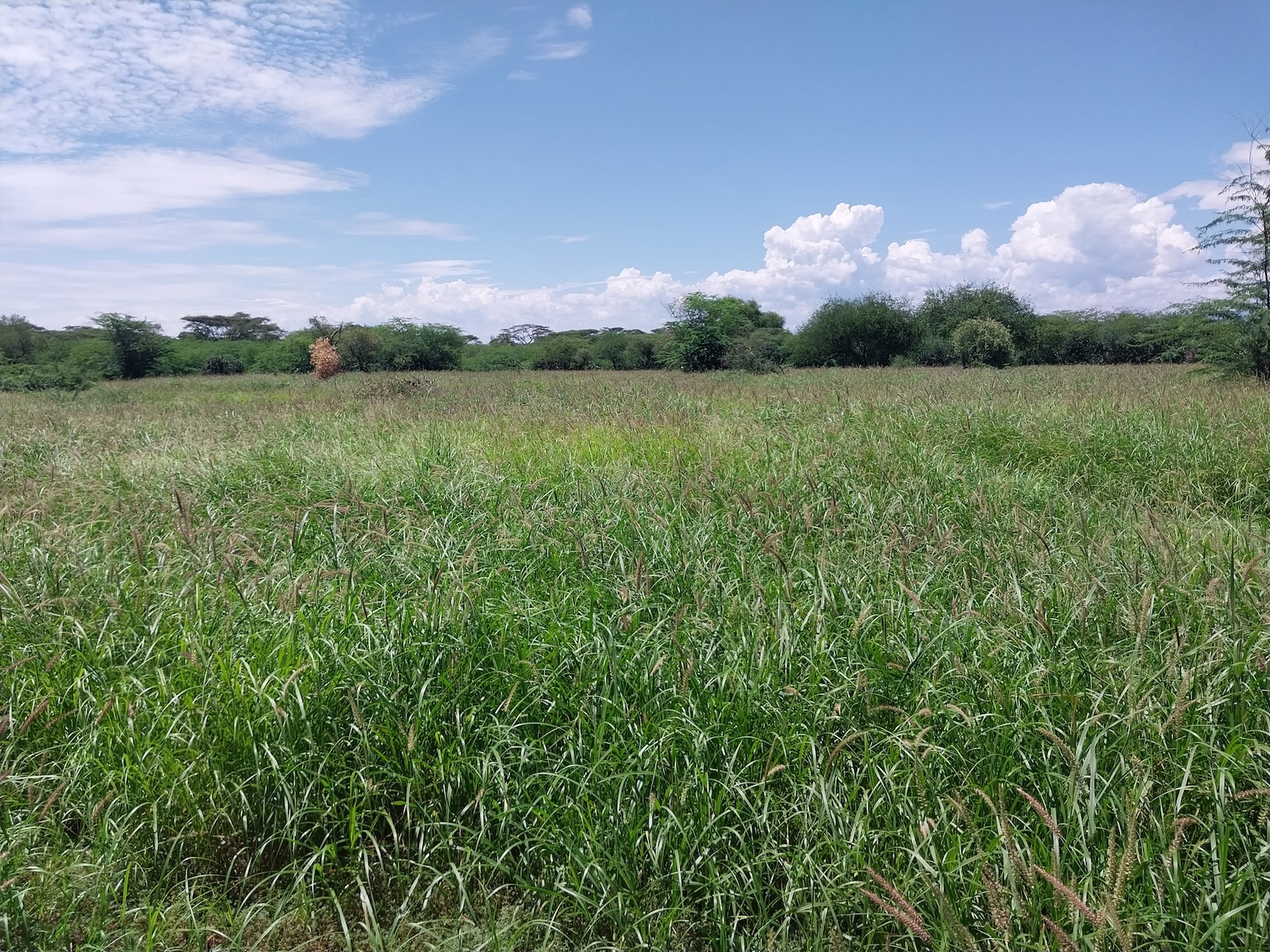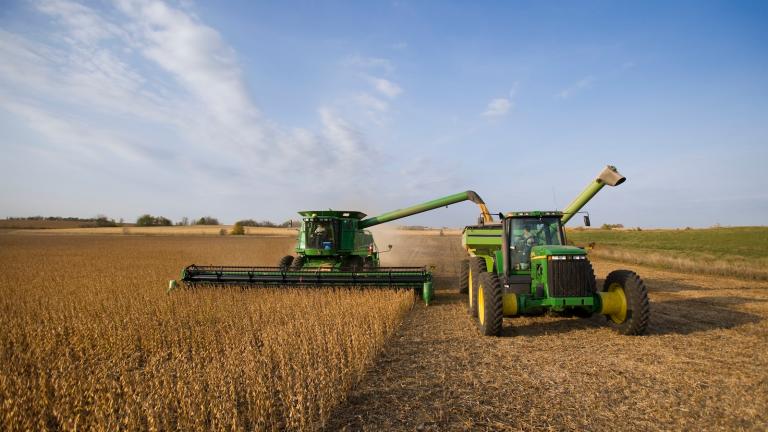Simon Kitol’s 25-acre farm in western Kenya teems with maize, tomatoes, and beans, but also an invasive menace: Prosopis juliflora, better known as the mathenge plant. Its long roots steal water from his crops, and the shrub takes up valuable room for growing food. Kitol’s livestock also dine on the mathenge pods, which are loaded with sugar, causing even more problems.
“It damages their teeth, and eventually the cows or goats die,” Kitol said. The thickets also provide cover for predators like wild dogs and hyenas. “They hide there because it is so thick that you can’t see them. At night, when the goats or sheep walk around, they are attacked and killed.”
Last year, experts with Penn State’s PlantVillage project, which helps smallholder farmers adapt to climate change, arrived to train Kitol and others in the area on a clever way to turn mathenge from a problem into an asset. Workers gather up those troublesome weeds — biomass — and convert it into biochar, concentrated carbon that they “charge” with nutrients by mixing it with manure. Farmers then apply the mixture to their fields, sometimes planting grass that provides fodder for livestock. Kitol said that the biochar helps his soils retain water and improves their fertility, leading to higher yields.
Well beyond Kenya, biochar is having a moment: The worldwide market was worth $600 million last year, and could rise to over $3 billion next year. Anywhere people are producing waste biomass — corn stalks, weeds, dead trees — they’re also producing a powerful tool for sequestering carbon and improving soils. And if farmers can prove how much biomass they’re turning into biochar, they can prove how much carbon they’re putting back into the ground. Through a group like PlantVillage, a company can then pay those farmers to offset its carbon emissions. (Biochar in general accounts for over 90 percent of durable carbon credits that have already been delivered worldwide.)
So with biochar, farmers are getting a new source of income and a way to better retain rainwater and boost yields. They’re helping mitigate climate change while adapting to its ravages. “Helping to solve an invasive species and land degradation problem, and produce biochar at the same time, is amazing,” said James Gerber, a data scientist who studies agriculture at the nonprofit climate group Project Drawdown. “Anything that gets money into the hands of smallholder farmers in Africa is probably just a good thing. But if it’s part of a functional, verifiable carbon-credit program, even better.”
The trick to making biochar is pyrolysis. As people have known for millennia, if you expose biomass to very high temperatures but in a low oxygen environment, it doesn’t combust into all-consuming flames; it turns into a kind of charcoal. Companies can do this with big industrial chambers, producing the biochar you can buy for your garden. Smallholder farmers can do it by digging a pit and adding biomass in layers, which restricts oxygen to the smoldering fire at the bottom. A simple kind of metal kiln does the same.

Whatever the method, the plant material isn’t fully combusting and billowing smoke. With biochar, you end up with concentrated, solid carbon. “It’s essentially coal,” said David Hughes, founder of PlantVillage. “It goes into the ground and it doesn’t break down, and this is because of the temperature you’ve exposed it to.”
Because biochar is so spongy, it helps the soil retain more water — an especially welcome trait given the worsening droughts in Africa and elsewhere. But that sponginess also demands special care when applying to a field. “If you just put biochar into the soil, it will suck up all the nutrients in there, and your plants will do worse,” Hughes said. “So you have to charge it with nutrients. You can do that with compost or NPK — nitrogen, phosphorus, potassium — blends.”
Traditionally, a farmer might burn piles of waste like corn stalks, emitting carbon into the atmosphere. If different farms across a landscape are doing this after a harvest, air quality plummets and imperils human health.
So for a group like Biochar Life, which provides carbon removal offsets for biochar, the first step is to get a farmer to stop processing their waste biomass the old way. “We need to prove that the farmer didn’t burn it or just leave it there and let the biomass decompose and create methane,” said Aom Kwanpiromtara Suksri, the co-founder and global head of development and compliance at Biochar Life, which has offices in Asia and Africa and has formed a partnership with PlantVillage.

To be sure, carbon offset systems have been plagued with problems. One is a perverse incentive to deforest an area and plant trees again, selling those credits to companies. Where there’s been deforestation from logging or agriculture, planting a bunch of a single species of tree doesn’t create a proper ecosystem. There’s no boost to biodiversity, and tree plantations don’t sequester nearly as much carbon as a real forest.
By contrast, Biochar Life says its offset system is easier to quantify, and that it’s so far distributed more than $300,000 to farmers, and $265,000 to local teams that verify the credits. “We can’t generate a credit until we’ve proven that we’ve generated biochar, and that biochar has been charged and put back into the ground,” said Matt Rickard, Biochar Life’s chief operating officer.
Then there’s an issue of permanence: If farmers plant a bunch of trees and a drought strikes, and those trees all wilt or catch on fire, their carbon is going right back into the atmosphere. Scientists are still working out how long biochar can last in different kinds of soils and climates, but indications are that it can last thousands or possibly millions of years. And compared to waiting for a tree to grow and capture carbon, adding biochar to soil sequesters the carbon in the ground immediately.
“Biochar, it’s kind of chemically locked in — it’d be very difficult to reverse that,” Gerber said. “For me, that is the most important reason that biochar has greater potential for carbon credits.”
And unlike planting a new forest and walking away, farmers can keep producing biomass, charging it with nutrients, and adding it to the soil year after year. At the very least, a smallholder farmer like Kitol is getting a better handle on an invasive species while boosting yields and preparing his soils for the drier times ahead. “I see the future of biochar as promising,” Kitol said. “Biochar will be widely used as more people recognize its benefits.”




